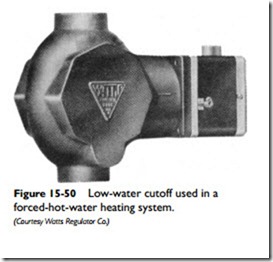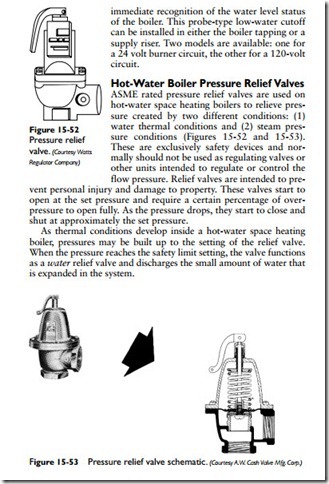Hot-Water Boiler Low-Water Cutoffs
A low-water cutoff device, such as the one shown in Figure 15-50, can also be used in a hot-water heating system to provide protection against a low-water-level condition in the boiler resulting from runaway firing caused by malfunctioning controls or a break in the return piping. The low-water cutoff device should be installed in the piping so that the raised line cast on the float chamber body is on a level with the top of the boiler. The drain valve located directly
below the low-water cutoff should be opened periodically to flush mud and sediment from the float chamber. It is recommended that this be done at least once a month.
Note
The ASME Boiler and Pressure Vessel Code requires that hot- water space heating boilers be equipped with a low-water cut- off device only if the boiler input is greater than 400,000 Btu/h. However, on coil-type boilers, where the flow of water is required to prevent overheating, a flow switch or similar device can be used instead of the low-water cutoff switch to shut off burner operation.
Some hot-water (hydronic) space heating systems have piping for the radiators, convectors, or tankless water heaters installed below the minimum safe water level of the boiler. A low-water cut- off should be installed in these systems for low-water protection.
The probe-type low-water cutoff illustrated in Figure 15-51 has a green “power on” LED and a “low-water condition” red LED for
immediate recognition of the water level status of the boiler. This probe-type low-water cutoff can be installed in either the boiler tapping or a supply riser. Two models are available: one for a 24 volt burner circuit, the other for a 120-volt circuit.
If both water and steam are present in a hot-water space heating boiler, the firing controls probably are malfunctioning or have completely broken down. This may result in runaway firing of the boiler, which could cause the boiler water to reach steam-forming temperatures, creating a steam pressure condition. Under these circumstances, the relief valve functions as a steam safety-relief valve. The steam is discharged at a rate or faster than the boiler can generate it, thus restoring system pressure to a safe level. Although these valves are steam rated and have an emergency Btu steam dis- charge capacity if runaway firing conditions occur, they should not be continuous steam service.
In order to be completely effective, the safety relief valves used on hot-water space heating boilers must be designed to discharge the excessive water pressure created by thermal expansion and also the excessive steam pressure resulting from runaway emergency temperature condition


